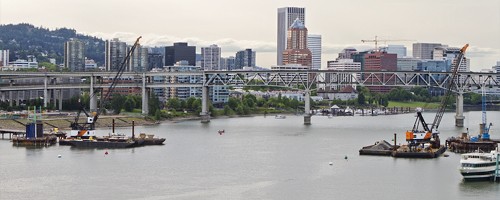On May 22, TriMet was awarded $745.2 million in federal grants from the Federal Transit Administration to help with the completion of the MAX orange light rail line. Along with the $85 million in federal aid that TriMet received on May 17, the federal government will provide nearly 50 percent of the cost of the $1.49 billion rail line project. According to a fact sheet provided by TriMet Chief Media Relations Officer Mary Fetsch, the grants are a nod toward the beginning of construction.
TriMet receives federal grant for Portland-Milwaukie MAX line

On May 22, TriMet was awarded $745.2 million in federal grants from the Federal Transit Administration to help with the completion of the MAX orange light rail line. Along with the $85 million in federal aid that TriMet received on May 17, the federal government will provide nearly 50 percent of the cost of the $1.49 billion rail line project. According to a fact sheet provided by TriMet Chief Media Relations Officer Mary Fetsch, the grants are a nod toward the beginning of construction.
According to TriMet, the new rail line will be built with this goal: “Expanding transit options is essential to the livability and economic vitality of our growing region, which is expected to add one million new residents and nearly 100,000 new jobs within the project corridor by 2030.” The project will also promote sustainability and wildlife and habitat conservation, with TriMet working closely with U.S. Department of Agriculture.
“Our region has been able to build large, critical transportation projects because we work together,” Portland Metro Councilor Carlotta Collette said. “No single city or county could have provided half the cost of this project, but together we’ve been able to match the federal support to expand transportation options in our region.”
Federal Transit Administrator Peter Rogoff signed the grant alongside Sen. Suzanne Bonamici (D-Ore.). “The Portland-Milwaukie Light Rail extension is critical for continued economic growth in the Portland metro area,” he said. “I am thrilled to see that the U.S. Department of Transportation has once again recognized the metro area’s record of innovative transportation planning.”
After nearly a decade of planning and community outreach, project partners such as Clackamas County and the Portland Development Commission were able to celebrate the final agreement before construction began. While some areas of the project, like the new light rail bridge, have already began construction, the rail line is far from complete.
“Light rail is an investment in the future that has the very real potential to reduce greenhouse gas emissions and our dependence on foreign oil while also creating domestic manufacturing jobs and attracting economic development,” Sen. Ron Wyden said in a statement regarding the $85 million federal grant posted on his website.
The construction of an extended 7.3 miles in rail line is expected to create up to 14,500 new jobs and $573 million in personnel salary. While many of these jobs will be directly involved with the construction and maintenance of the Orange Line, it is expected that businesses located along the rail route will be positively affected and allow the creation of new business and jobs. Already-existing businesses are predicted to find an increase in customer purchases, which will allow these local venues to grow and flourish.
“Milwaukie and Oak Grove are two of our region’s gems that have not been discovered,” Collette said. “Both of these areas will blossom with the investment that accompanies light rail. Housing values go up, and new businesses locate near the lines. I think we will see major revitalization efforts in both of these areas as the project nears completion,” she added.
Areas like the South Waterfront district are hopeful for the business boom the Orange Line is predicted to bring. The 120 acres of Portland’s central area is the city’s largest source of developmental vacant land. With the construction of the new rail line, it is expected that public and private investors will take an interest in the area. The project has also allowed TriMet and other companies such as ZRZ Realty to collaborate and create new partnerships. TriMet and the project’s partners will also provide assistance in relocating businesses if the light rail makes relocating necessary.
ZRZ and TriMet have collaborated to address issues behind hazardous material mitigation and coordinate the construction of the light rail. ZRZ has also donated land under the light rail bridge to help TriMet determine South Waterfront’s rail alignment and reduce remediation costs by addressing low-level contaminated soil underneath light rail alignment.
ZRZ Manager of Development Planning Rick Saito is excited for the future of the South Waterfront due to the new rail line. Over the next 20 years, ZRZ is planning to address new market and partnership opportunities that will arise after the completion of the rail line, including new developments within the Oregon Health and Science University.
Portland State is also expected to expand due to the light rail. The new MAX line will allow students of the Milwaukie area to travel more quickly to school and to the new Collaborative Life Sciences Building currently under construction at the South Waterfront. The new building, a collaboration between the Oregon University System, OHSU and PSU, will house life and health sciences research, giving PSU’s biology and chemistry departments much needed classroom and research space. PSU is being allotted 40,000 square feet of the building, according to the CLSB project fact sheet.
Additionally, the new building will house collaborative lab space to be used by both OHSU and PSU research teams, an expansion of OHSU’s School of Dentistry and School of Medicine, and OHSU and Oregon State University’s collaborative pharmacy program. The building is expected to be partially open for the fall 2013 academic term and fully open in spring 2014.
Due to limited parking space availability at the CLSB, students are encouraged to find other modes of transportation until the opening of the MAX line. According to PSU Transportation and Parking Services Associate Director Sarah Renkens, parking permit details and rates are still in discussion, and PSU parking permits will most likely not be valid at the CLSB.
Students needing transportation between PSU and the South Waterfront will have a variety of options, such as the Portland Streetcar or a shuttle provided by the university if the streetcar cannot provide adequate accommodations to students who need to travel between classes.
Students who prefer biking as their method of transportation will be able to access free short-term parking on the CLSB campus. Long-term parking can be secured by paying a small fee inside the CLSB.
“By fall of 2013, we also expect to have bike-sharing kiosks at both locations,” Renkens said, “allowing those without a bike to simply check one out and ride it to the main campus or CLSB (or any of the other bike share stations throughout the city).”
The remainder of needed funding for the MAX rail Orange Line will come from local agencies and project partners. Altogether, MAX rail lines cover 60 miles within the Portland Metro area. When completed in September 2015, the Orange Line will have 10 new stations and a first-of-its-kind, multi-modal bridge that will accommodate light rail, buses, bike riders, pedestrians and possibly the streetcar. The bridge will not accommodate private vehicles.







Ya it’s all good as they say right?
Too bad the rest of the transit system is falling apart.